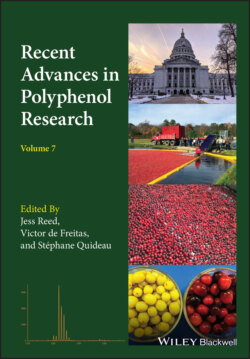Читать книгу Recent Advances in Polyphenol Research - Группа авторов - Страница 49
3.5 Probing the Mechanisms Behind Polyphenol‐rich Traditional Medicines Bioactivity
ОглавлениеTraditional ecological knowledge concerning the medicinal use of polyphenol‐rich plants reaches back many hundreds and even thousands of years, but the naturopathic doctors and healers who routinely rely on wildcrafted plants are frequently loath to share their knowledge with anyone from outside the native communities. The reason for this reluctance has been the exploitation (and resultant overharvesting and/or theft) of native resources by outsiders in the past, which has undermined the authority and historical access of traditional healers (Andrae‐Marobela et al. 2012). The reductionist paradigm of Western science marginalizes the holistic approaches of wildcrafted medicine, and was imposed on top of indigenous knowledge systems during colonialism, which has made “bioprospecting” a disrespected term in the opinion of many elders in native tribal groups (Kellogg et al. 2010).
Harvest, attempted commercialization, and even in‐depth analytical research on indigenous polyphenol resources carries obligations related to ethics, equitable benefit sharing, and intellectual property, covered in part by the CBD (Convention on Biological Diversity, a multilateral international treaty opened for signature in 1992). Close collaboration between scientists and members of indigenous communities is critical for thorough identification and validation of local, endemic plant resources (Schmidt and Cheng 2017), but these trust issues frequently prevent outsiders from gaining access into traditional ecological knowledge about culturally important species. In order to bridge these concerns, our collaborating laboratory teams from three US universities (www.gibex.org) joined together to produce a portfolio of mobile biodiscovery kits. The interactive experiments in the kits enable participation of both elders and youth in bioexploration and therapeutic lead discovery, focusing on indigenous local plants with a history of medicinal use in traditional ecological knowledge (Kellogg et al. 2010; Flint et al. 2011; McOliver et al. 2015). This unconventional approach provided a sustainable and equitable entrée into traditional cultures and local healing practices, and allowed us to interface with tribal groups in Africa, Asia, and the Americas to create a bridge between traditional knowledge and chemical/physical science discovery experiments.
The mobile discovery workshops have been added into high school and junior college curricula in several participating countries including the USA (Alaska and North Dakota). The mobile biodiscovery kits are simple, straightforward, rapidly deployed bioassays. Experiential learning is the key to resolving the bioactivity of the natural resources, and all of the demonstration/instruction takes place in a team‐centered environment. Initial scouting in the forest or field is led by traditional healers, identified plantings in the wild are coded with GPS coordinates, and samples of identified local medicinal species undergo botanical authentication and are vouchered as herbarium specimens. Next, small quantities of plant material (leaves, bark, roots, stems, fruits) are ground, and crude ethanolic extracts are prepared and tested in a series of screens (antifungal, antibacterial, antiprotozoal, enzyme inhibitory, etc.) (Table 3.1). Assays can be conducted using only a few grams of plant material, and allow the participants to identify bioactive properties of plants used in traditional medicines that have been underappreciated by modern pharma‐based medicine (Figure 3.2). The strategy has successfully engaged youth from junior high school to college age in science discovery that is hands on, and utilizes plants with intrinsic cultural significance (Kellogg et al. 2010, 2016). The traditional ecological knowledge of ethnic groups regarding harvest and use of polyphenol‐rich plants can be lost due to habitat destruction (wars, overharvesting, development or clearing of wild lands for agriculture), but it can also be sidelined or lost when younger generations lose interest in the traditional knowledge of their elders (Schmidt and Klaser Cheng 2017). Community elders report a loss of interest in traditions and subsistence foods among tribal youth, and with that disconnect, a shift to commodity and fast‐food diets which increases incidence of diabetes and obesity. Due to these trends, the mobile biodiscovery approach has been widely accepted and encouraged by tribal elders as a means to refocus on traditional values (Kellogg et al. 2010).
Following the leads provided by naturopathic healers in various global settings, the mobile biodiscovery approach was used to shed light on the mechanistic properties of some of the traditionally wildcrafted polyphenol‐rich plants.
